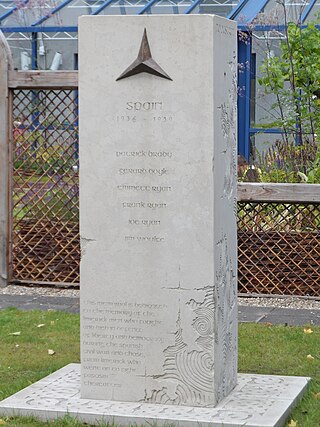
George William Frederick Villiers, 4th Earl of Clarendon, was an English diplomat and statesman from the Villiers family. Following diplomatic postings, he served a succession of Whig and Liberal administrations. This included as Viceroy in famine-stricken Ireland and, on the first of three occasions as Foreign Secretary, as the United Kingdom's chief representative at the Congress of Paris which ended the Crimean War.

Joseph Mary Plunkett was an Irish republican, poet and journalist. As a leader of the 1916 Easter Rising, he was one of the seven signatories to the Proclamation of the Irish Republic. Plunkett married Grace Gifford in 1916, seven hours before his execution.

George Noble Plunkett was an Irish nationalist politician, museum director and biographer, who served as Minister for Fine Arts from 1921 to 1922, Minister for Foreign Affairs from 1919 to 1921 and Ceann Comhairle of Dáil Éireann in January 1919. He served as a Teachta Dála (TD) from 1918 to 1927. He was a Member of Parliament (MP) for Roscommon North from 1917 to 1922.

Rathmines is an affluent inner suburb on the Southside of Dublin in Ireland. It begins at the southern side of the Grand Canal and stretches along the Rathmines Road as far as Rathgar to the south, Ranelagh to the east, and Harold's Cross to the west. It is situated in the city's D06 postal district.

Inghinidhe na hÉireann was a radical Irish nationalist women's organisation led and founded by Maud Gonne from 1900 to 1914, when it merged with the new Cumann na mBan.

Protestant Irish Nationalists are adherents of Protestantism in Ireland who also support Irish nationalism. Protestants have played a large role in the development of Irish nationalism since the eighteenth century, despite most Irish nationalists historically being from the Irish Catholic majority, as well as most Irish Protestants usually tending toward unionism in Ireland. Protestant nationalists have consistently been influential supporters and leaders of various movements for the political independence of Ireland from Great Britain. Historically, these movements ranged from supporting the legislative independence of the Parliament of the Kingdom of Ireland, to a form of home rule within the United Kingdom of Great Britain and Ireland, to complete independence in an Irish Republic and a United Ireland.

William Monsell, 1st Baron Emly, PC was an Anglo-Irish landowner and Liberal politician. He held a number of ministerial positions between 1852 and 1873, notably as President of the Board of Health in 1857 and as Postmaster General between 1871 and 1873.

Sir Thomas Drew was an Anglo-Irish architect.
Donagh MacDonagh was an Irish writer, judge, presenter, broadcaster, and playwright.

Grace Evelyn Gifford Plunkett was an Irish artist and cartoonist who was active in the Republican movement, who married her fiancé Joseph Plunkett in Kilmainham Gaol only a few hours before he was executed for his part in the 1916 Easter Rising.

Irish Socialist volunteers in the Spanish Civil War describes a grouping of IRA members and Irish Socialists who fought in support the cause of the Second Republic during the Spanish Civil War. These volunteers were taken from both Irish Republican and Unionist political backgrounds but were bonded through a Socialist and anti-clerical political philosophy. Many of the Irish Socialist volunteers who went to Spain later became known as the Connolly Column.
Henry Seymour Guinness was an Irish engineer, banker and politician.
Sir Edward Newenham (1734–1814) was an Irish politician.

Sidney Sarah Madge Czira, known by her pen name John Brennan, was a journalist, broadcaster, writer and revolutionary. She was an active member of the revolutionary group Inghinidhe na hÉireann and wrote articles for its newspaper, Bean na h-Éireann, and for Arthur Griffith's newspaper Sinn Féin.

Nellie Gifford was an Irish republican activist and nationalist.

Muriel MacDonagh an Irish nationalist, and member of Inghinidhe na hÉireann. Her husband Thomas MacDonagh, was one of the signees of the Proclamation of the Irish Republic, which led to the Easter Rebellion.

Geraldine "Gerry" Plunkett Dillon (1891–1986) was an Irish republican and member of Cumann na mBan, best known for her memoir All in the blood. She was the sister of Joseph Mary Plunkett, a signatory of the 1916 Proclamation of the Irish Republic.

Kathleen "Kathy" Barry Moloney was an Irish republican activist, and trade unionist. She was the elder sister of Kevin Barry, an Irish republican rebel who was executed in 1920.
Kay Keohane-O'Riordan was an Irish social campaigner and communist.

Thomas Dillon was an Irish chemist and nationalist.



















